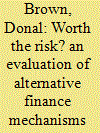|
|
|
Sort Order |
|
|
|
Items / Page
|
|
|
|
|
|
|
| Srl | Item |
| 1 |
ID:
191212


|
|
|
|
|
| Summary/Abstract |
Decarbonizing Europe by 2050 requires significant capital investments in renewable energy (RE). The weighted average costs of capital (WACC) greatly impact RE production costs and influence the government support payments needed for the financial viability of RE projects. Reducing the risks for RE investors can decrease WACC and ensure that the EU meets its climate targets at the least cost. We investigate the potential for lowering support payments to RE projects by de-risking financing conditions through measures including revenue stabilization and low-risk auction designs for solar PV and onshore wind across 21 countries in Europe. We find that de-risking debt is almost twice as effective as de-risking equity. On average, support payments can be reduced by 3.3 EUR/MWh and 1.9 EUR/MWh, respectively, and in some cases, fall to zero. The effects differ across countries, higher-risk countries like Greece would experience more significant benefits from de-risking than lower-risk countries like Denmark and Germany, where support costs depend more on investment variables such as capacity factors. Overall, we show that WACC depends largely on country risk. Nonetheless, de-risking policies like revenue stabilization can improve the investment climate for RE, reduce the need for government support, and contribute to achieving decarbonization targets.
|
|
|
|
|
|
|
|
|
|
|
|
|
|
|
|
| 2 |
ID:
166731


|
|
|
|
|
| Summary/Abstract |
Wind power represents a key component of Turkey's energy strategy. Increased investment will be required to meet Turkey's wind power target and, as such, there is a need to understand the viability of wind power projects there. The cost of capital is a crucial element in wind power investment decisions owing to the high capital intensity of wind power plants. A reduction in the cost of capital through support policies can lower overall project costs and increase investment. We estimate the cost of capital for wind power projects in Turkey using data on 138 installations that participated in the Turkish feed-in tariff scheme in 2017. Our estimates indicate an upper bound of 12% for the cost of capital. This suggests the cost of capital for wind power projects in Turkey is not higher than in south-eastern European Union countries. However, because of adverse macroeconomic conditions, the cost of Turkey's main renewable support scheme increased by 46% between 2016 and 2017 in Turkish lira terms. We argue that continued commitment to the current support schemes by the Turkish authorities is crucial for the development of the Turkish wind power sector.
|
|
|
|
|
|
|
|
|
|
|
|
|
|
|
|
| 3 |
ID:
180847


|
|
|
|
|
| Summary/Abstract |
The recent rise of auctions to allocate support payments for renewable energy projects creates new uncertainties during project development and causes a decrease in support levels. We investigate the effects of the shift to auctioning on costs of capital (CoC) and financing conditions through semi-structured and focus group interviews with 40 experts in onshore and offshore wind project development and financing in Europe. We find that auctions create a competitive environment that pressures the industry into accepting higher risks and lower returns. Banks have reduced debt margins, while large investors decreased hurdle rates and equity returns, despite additional risks from auctions, such as uncertainty about future award prices, allocation and qualification risks. The risk of being awarded support and incurring sunk costs makes smaller bidders averse to participating in auctions. Competitive bidding may also decrease secured revenues and increase offtaker risks, especially when combined with sliding premiums. Despite increased price risk, the competitive pressure driven by project sponsors, seems to lower financing costs and hurdle rates, thus decreasing CoC for offshore projects. To reduce negative impacts on CoC and financing, policymakers can minimise additional risks, by adopting remuneration schemes that stabilise revenues, and supporting smaller actors through removing participation hurdles.
|
|
|
|
|
|
|
|
|
|
|
|
|
|
|
|
| 4 |
ID:
166405


|
|
|
|
|
| Summary/Abstract |
Improving energy efficiency, de-carbonising heating and cooling, and increasing renewable microgeneration in existing residential buildings, is crucial for meeting social and climate policy objectives. This paper explores the challenges of financing this ‘retrofit’ activity. First, it develops a typology of finance mechanisms for residential retrofit highlighting their key design features, including: the source of capital; the financial instrument(s); the project performance requirements; the point of sale; the nature of the security and underwriting the repayment channel and customer journey. Combining information from interviews and documentary sources, the paper explores how these design features influence the success of the finance mechanisms in different contexts. First, it is shown that a low cost of capital for retrofit finance is critical to the economic viability of whole-house retrofits. Second, by funding non-energy measures such as general improvement works, finance mechanisms can enable broader sources of value that are more highly prized by households. Thirdly, mechanisms that reduce complexity by simplifying the customer journey are likely to achieve much higher levels of uptake. Most importantly we discuss how finance alone is unlikely to be a driver of demand for whole-house retrofit, and so instead should be viewed as a necessary component of a much broader retrofit strategy.
|
|
|
|
|
|
|
|
|
|
|
|
|
|
|
|
|
|
|
|
|